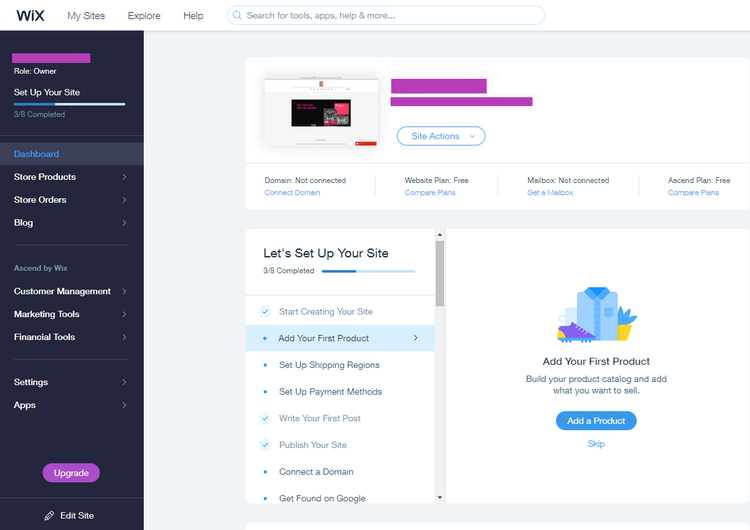The term digital marketing is so all-encompassing that sometimes the biggest digital marketing asset you have for advertising to a database of potential leads leaves you stumped on how best to use it.
Still, your website can be one of your strongest marketing tactics. Using thoughtful website strategies, you can promote your brand and attract prospects’ attention from your website.
What to consider when marketing your website
Using your website as a marketing arm is a classic and robust example of inbound marketing at its core.
As with any online business strategy, there are certain considerations you should think through before jumping right into a marketing plan.
Is your website optimally designed?
Before you ramp it up with some webpage marketing, you should first conduct a website analysis to make sure your site design is conducive to a smooth user experience.
Take a look at your site map and make sure it flows well. Is your navigation bar easy to follow? Do all backlinks work? Is your search function intuitive?
Have someone come in with a fresh set of eyes, too, and click through to give you an outsider’s perspective on navigation.
Another important step? Check out your site from multiple browsers. Just because it looks top-notch in Chrome, don’t assume all visitors will be using Chrome. Same with devices: test out desktop, mobile, and tablets. Universal experiences are a tentpole principle of marketing.
Before you turn your focus to website marketing strategies, make sure your site is putting its best foot forward for visitors.
Check out those page load times
Another thing you’ll want to investigate is load times. This will not only impact the user experience, in a bad way if they take too long to load, but long load times also negatively affect SEO.
There’s nothing like a page taking forever to load to make people exit out of your site altogether. And the algorithms in Google and other search engines take that into account, ranking a slow loading site lower and lower.
Make sure your current content is organized and focused
If you’re going to attract people to your website, you’ll need it to speak to your niche. Outside of your analysis for general working order, you need to make sure you have your focus nailed down in terms of your target demographic and goals.
Rather than trying to market to everyone, make sure your content and copy are deliberate and focused on your target market.
Website marketing strategies you can use
After you’ve thought about the technical aspects and the big picture, you can start making tweaks and updates to your site as part of your overall internet marketing strategies.
1. Content marketing
This one is a biggie. Creating valuable pieces that are relevant to your audience goes a long way to both attracting and engaging people.
Offering something worth their time to read or view builds trust and a relationship with an audience.
How to get the most out of content marketing:
It’s not just about writing up 100 white papers or flooding your page with videos. Content marketing needs to be well thought out and approached like any other marketing collateral strategy.
- Create a content calendar: Keep yourself on track by publishing regularly, with content tied back to a goal or central theme. To help you stick to a schedule, develop and follow a content calendar. Further maximize your content marketing efforts by scheduling posts to share on social media.
- Make different content types: Don’t just stick to one kind of content. Keep the offerings varied and fresh with blogs, infographics, e-books, videos, etc.
2. SEO
Google’s first page search results has become so refined and so crucial that anything second page and beyond can almost be considered the dark web for some. That said, a strong SEO presence is non-negotiable these days.
And while a paid search campaign may still be in the cards, put more of your energy into organic SEO. A reported 70-80% of users ignore paid advertising, according to business2community.com.
How to get the most out of SEO:
Hearing “SEO” may call to mind experts and obscurities, but the real secrets to succeeding are time and consistency, meaning you can do it on your own, by following some best practices. Good SEO can pull in leads. Put them, and the information they contain into your marketing database, so you can later push out content.
- Add images: Including even a single image in your content increases your search engine rankings.
- Repurpose content: Rather than continuously churning out something new, make the most of your old content by updating and republishing past blogs to increase visitor traffic.
3. Content upgrades
Take your content a step further by offering content upgrades. This is a vital part of your website marketing plans as it builds up your leads database.
Content upgrades are a great way to get your prospects’ email addresses and send them newsletters. They feel they get something of value, and you get the key to their inboxes to nurture them.
The more leads you acquire, the more opportunities to connect with audience targets and more chances to use other marketing skills.
How to get the most out of content upgrades:
There’s more than enough spam in the email world, so getting people to give over their email involves a compelling argument from your side.
- Offer useful, helpful content: The information you offer as a downloadable (a white paper, an e-book, checklist, etc.) needs to be unique and not readily found elsewhere. Really play up its importance and excitement to bait the hook.
- Get creative with the ask: Simply asking outright for an email can come off as sales-y and drive people away. Be creative in your ask, for example, "Share this on Twitter for access to your e-book."
4. Blogging
A blog lets you publish regular, industry-specific news and ideas, and it positions you as a thought leader, or at least aware of things. Often, though, the blog suffers due to a lack of resources or time, and that is a huge missed opportunity.
Fresh content goes a long way to building trust, and a regularly updated blog shows you are active and current -- and helps you with ranking and showing up on Google search results.
How to get the most out of blogging:
Blogging is a lot more than just writing out a 200-word listicle and clicking ‘publish’ every week, though. An excellent online marketing strategy includes a good plan for your blog.
- Research topics: Do your research and make sure to offer thoughts on topics that are valuable to your customers alone. Sidebars and tangents may be tempting, but they will make you lose credibility and even some SEO ranking.
- Link to other site content: Your blog content shouldn’t sit as totally separate entities from the rest of your site. Link back to other parts of your website inside each blog, and even link out to reputable sources to build trust.
5. Email marketing
In any business, email marketing is a great way to stay connected with prospects while simultaneously cataloging their contact and behavioral information. But, to capture that information, you need to catch their attention in new ways to get people to sign up.
How to get the most out of email marketing:
This is a two-fold consideration. You don’t want to abuse the power of having an email marketing list, so be sure you only send out relevant, meaningful content that is of interest to your list. And when you are collecting email addresses, make it an easy process.
- Simplify signing up: You don’t really need a full-on fancy form with multiple data points to get your audience to sign up. Sometimes a simple sign up field at the bottom of a page with messaging such as “Get our weekly newsletter in your inbox” or something similar is enough to get new subscribers.
- Use pop-ups: While pop-ups can be annoying if overused, a single pop-up on just one or two pages can really grab attention. To catch the most attention, don’t reveal the pop-up as soon as someone clicks onto a page. Wait until they show some interest by spending 30-60 seconds on a page.
6. Place CTAs prominently
A call to action (CTA) is what grabs the attention of the reader and encourages them to take action that will either turn them into a lead or help nurture the relationship.
Use CTAs to call attention to email sign-ups, content upgrades, consultation requests, etc., and increase exposure to all your marketing channels.
How to get the most out of CTA’s:
Calls to action should be easy to see and engage with. But there is an art to creating them -- make sure they lead to something of value in return, and be smart about how you use them.
- Avoid “click here”: A button following a chunk of text simply saying “click here” looks cheap and a little sketchy. Opt for something more direct such as “get started” or “request now” to increase clicks.
- Give them options: Sometimes, people will skip the first link or glance right over it. The more opportunities you give them to click, i.e., multiple CTA paths, the higher the chance of them finally engaging with one.
Best CMS software to maximize your website marketing strategy
As part of any web or digital marketing strategy, the case for a good CMS software is a big one.
1. WordPress
A popular choice, WordPress is open-source, free, and feature-rich. Originally built as a blogging platform, it not only still excels in its content publishing capabilities but has grown to be optimized for e-commerce, small businesses, and much more.
You can manage multiple user permissions, store and incorporate media, customize themes, capture leads and data, integrate with CRMs, and pretty much anything else thanks to over 50,000 third-party plugins available.

You can truly have your site optimized for just about any marketing strategy with WordPress’s multiple plugin options. Image source: Author
2. Wix
At a perfect crossroads of affordable and highly functional, Wix offers the ability to quickly and intuitively customize your site and content without feeling over your head in terms of UX building or coding.
You can automate your e-commerce needs, showcase your artistic portfolios, streamline customer communication, animate, and even design an entire aesthetic around a central logo or color swatch.

The Wix dashboard is intuitive so you can focus your energy on optimizing and marketing your site rather than building it on the backend. Image source: Author
3. Squarespace
While it started as, and still excels at being, an e-commerce go-to, Squarespace has evolved into a sleek content management system.
It offers up appropriate thematic choices for your industry, intuitive templates for streamlining content, advanced style editing, marketing analytics, and even top tier image sourcing with an integration to Unsplash and Getty images.

Squarespace’s well-organized template choices go a long way to keeping your site easy to navigate. Image source: Author
The website is an underrated marketing hero
When it comes to small business marketing, every action matters. Optimizing your website and making it proactive for inbound leads puts you leaps and bounds ahead of the game.
Be sure to be deliberate and strategic in the options you employ, and you should see success follow.
Our Small Business Expert
We're firm believers in the Golden Rule, which is why editorial opinions are ours alone and have not been previously reviewed, approved, or endorsed by included advertisers. The Ascent, a Motley Fool service, does not cover all offers on the market. The Ascent has a dedicated team of editors and analysts focused on personal finance, and they follow the same set of publishing standards and editorial integrity while maintaining professional separation from the analysts and editors on other Motley Fool brands.